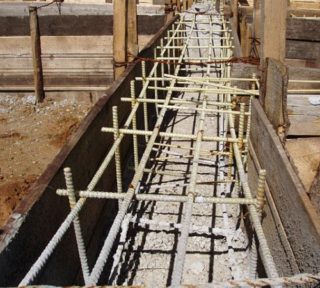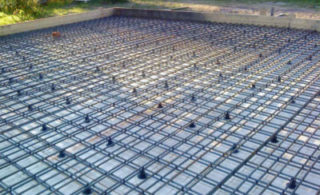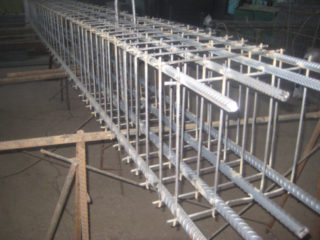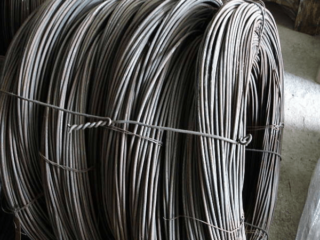The foundation is the basis for any type of building, regardless of its size and purpose. The most reliable, strong and durable option for creating a support system is deservedly considered a reinforced concrete foundation. Occupying a relatively small volume at the base, the reinforcement cage performs a number of important and responsible functions. The steel frame is not a set of randomly welded rods, but a mathematically sound structure, the assembly of which must be approached correctly and in each case individually.
Reinforcement cage device

The reinforcement frame as part of the foundation performs the function of a kind of skeleton, which takes on the torsion and bending loads arising during the operation of the house. Because iron is hard enough, deformation occurs slowly, allowing relatively brittle concrete to take on new shapes.
General structure of the reinforcement cage:
- Longitudinal rods. Make up a base that runs along the entire length of the support structure. Reinforcement of 10-16 mm is used depending on the mass of the structure.
- Vertical fragments. Connect the horizontal lines in the volumetric skeleton. A material similar to them is taken.
- Framework. They are made in triangular or rectangular shape. They serve to give the structure a spatial configuration.
- Shaped details. These are clamps in the shape of the letters "G" and "P" used to join longitudinal elements in the corners and abutments. They are made using cold bending on a pattern.
- Supports. They are placed under the reinforcement cage for the foundation to prevent metal contact with the ground.
- Spacers. They are fixed on the sides of the frame, butt to the formwork for its rigid fixation.
- Fasteners can be considered as part of the frame. These include couplings, clamps, plastic ties, and wire ties.
In retail outlets, frames of industrial production are presented, adapted to the dimensions of the support systems, which are used in private, commercial and industrial construction. Products are characterized by precision and high quality, save time and effort.
Homemade skeletons are made with a non-standard layout, as well as in order to save the construction budget.
Varieties of designs

In construction, support systems are used, the configuration of which is determined by the type of building, design load and installation location.
The following types of frames are distinguished by shape:
- Flat. They are two layers of longitudinal and transverse rods, forming a lattice with rectangular cells. They are used for reinforcing slab structures that are not designed for high loads.
- Volumetric. More complex products that have three dimensions - length, width and height. They are used to create support systems with a thickness exceeding 20 cm.
- Increased density. Such structures are made for support systems that are made for massive structures or for operation in complex and heaving soil. The difference from standard structures lies in the use of more durable and high-quality reinforcement, a decrease in the step and a change in the configuration of its location.
For each structure, its own layout of the reinforcement is selected or redesigned.
Styling features

Since there are several types of foundations, the frame for each of them has its own characteristic features.
There are the following styling options:
- For strip foundations. Depending on the height of the slab, beams are used, laid in one, two or more rows. The height of each fragment is 2–3 times its width. Particular attention is paid to the corners of the reinforcement cage for strip foundations, where the connection is made with an overlap or shaped parts with additional reinforcement with jumpers or frames.
- For pile foundations. Reinforcing frames for bored piles are made with a triangular or square section. Lowering into the column is carried out into an empty well or after filling it with a solution by pressing. It is more convenient to first install the reinforcement cages for the piles, and then fill the shaft with concrete, compacting it with a vibrator.
- For tiled foundations. The floor slab is under significant stress over the entire area, especially in the middle. To prevent sagging, a three-dimensional structure is always made of two gratings, connected by frames or bridges. Gain is not used.
The choice of the method of its assembly is of great importance for achieving the efficiency of the steel frame.
Manufacturing of reinforcing cages

Most private developers prefer to do the reinforcement of the foundation on their own, relying on their skill and counting on significant cost savings. There is a reason for this, but only if the assembly technology is chosen correctly.
Frame manufacturing options:
- Welding. The method is convenient, fast and simple, but not suitable for ordinary fittings. From overheating, the metal weakens, and the joints rust. Only steel grade "C" is suitable for this method.
- Plastic screed. Also an easy-to-follow approach that takes a minimum of time and effort to dock. The downside is that the screeds are quite expensive and become brittle in the cold. As a way out - products with a steel core.
- Annealed wire. This material is recommended by all professionals. Such fasteners have sufficient strength and the necessary degree of mobility so that after the concrete has matured, there are no internal stresses in it.
The assembly process itself should be performed on a flat surface; you can use stakes driven into the ground as a base. Before installation, the frame should be cleaned of dirt, grease, rust and treated with a corrosion agent.
Installation benefits
Thanks to the installation of a steel frame, the support system becomes much stronger, and most importantly, it is more resistant to vertical, horizontal and torsional loads. By binding the concrete, the reinforcement cage prevents cracks and breaks from appearing in it. Even under extreme pressure, deformation is insignificant and does not affect the integrity of the walls. Due to this, the service life of reinforced concrete support systems can reach 100-150 years, depending on the operating conditions.








